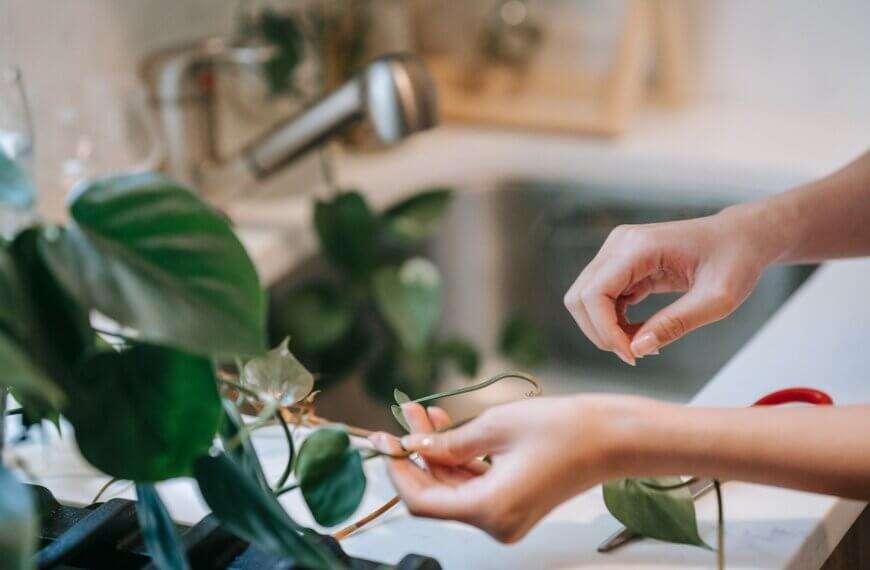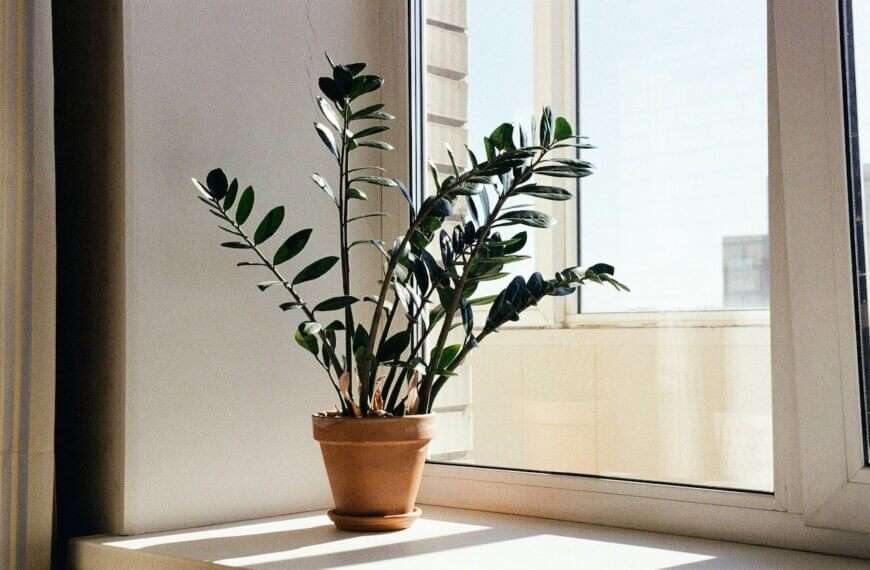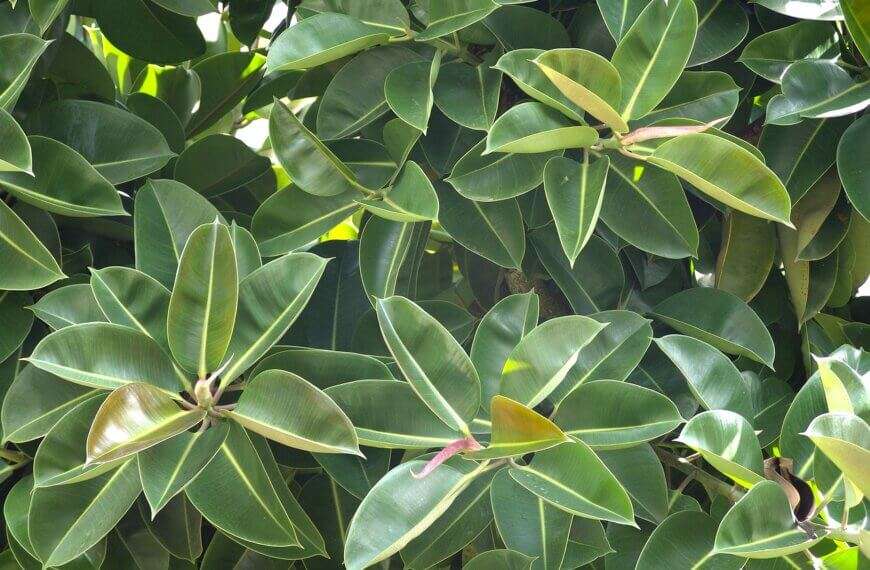Understanding Fiddle Leaf Figs
When it comes to understanding Fiddle Leaf Figs, certain aspects must be taken into consideration. These include humidity levels, sunlight exposure, watering frequency and soil composition.
| Aspect | Details |
| Humidity levels | Moderate to high humidity is essential. |
| Sunlight exposure | Bright, indirect sunlight, especially during morning hours is ideal. |
| Watering frequency | Water consistently but not too much. |
| Soil composition | A well-draining potting mix that retains moisture is best. |
Additionally, cleaning the leaves with a damp cloth and pruning with shears can help promote growth. This practice dates back centuries when Fiddle Leaf Figs were used as ornamental plants in Ancient Egyptian royal gardens.
Nowadays, Fiddle Leaf Figs are popular houseplants due to their beauty and easy-to-manage nature. As long as you follow the tips above, your Fiddle Leaf Fig will be living its best life!
Choosing the Right Pot and Soil
It’s essential for your fiddle leaf fig to get optimal pot and soil. Here are some tips to make sure it thrives!
- Pick a pot with good drainage and room for roots.
- Choose soil with right nutrients that drains well.
- Don’t use heavy or water-storing soil, it could cause root rot.
- Repot every 1-2 years for new soil and bigger pot.
- Use a self-watering pot to keep moisture levels even.
Let the top inch of the soil dry out before watering, so it won’t drown the roots.
Give your fiddle leaf fig all the care it needs. Don’t ignore any element of its upkeep, like the pot and soil. So, select a pot that’ll make it thrive!
Your fiddle leaf fig needs more light than a vampire on a tanning bed.
Providing Adequate Light
Light is essential for optimal growth of your Fiddle Leaf Fig. Mimic their natural habitat with bright, indirect light near a window on the east or west side of your home. Monitor their reaction to light; brown spots or wilted leaves can mean too much direct sun. Consider investing in LED grow lights when natural light is lacking. Keep them on for 10 hours and off at night to simulate day/night cycles.
Rotate your fig every few weeks for even growth. With proper care and lighting, you’ll have a thriving Fiddle Leaf Fig for years! Don’t forget to give it enough light – it’s the key to success.
Watering and Humidity Requirements
Moisture and humidity levels are key for your Fiddle Leaf Fig’s growth. Here’s what you need to know:
- Water when the top inch of soil is dry – once a week. Don’t overwater.
- Use a well-draining pot with holes on the bottom to prevent root rot.
- Keep humidity levels consistent with a humidifier or a tray of water near your plant.
- Avoid heaters, air conditioners, or drafty areas as they can affect water absorption rate.
Brown spots on leaves mean underwatering. Yellow leaves hint at overwatering. Test the soil with your finger before watering.
Too much sunlight can stress your Fiddle Leaf Fig. Place it in bright, indirect light for optimum growth. Move it every few months for maximum sun exposure.
Trim your fiddle leaf figs and give them plant food, just like you do for your own hair and tummy.
Pruning and Fertilizing
For a healthy fiddle leaf fig, pruning and fertilizing are essential. This supports its lifespan, foliage and growth.
- Use sharp, sanitized shears to cut off yellow/brown leaves.
- Cut away dead/damaged branches and trim stem tips for lateral branching.
- In spring/summer, use slow-release fertilizer. Dilute liquid plant food every few weeks during late winter – early fall. Don’t over-fertilize as it causes salt buildup in soil.
- Water regularly. Prune often to prevent overgrowth. Newly emerging leaves signify enough nutrients, not more fertilizer.
- Make cuts at defined angles for faster healing and prevent fungus/disease.
- Insufficient lighting can delay plant growth. Relocate your fiddle leaf fig or use light sources if needed.
- Pests/diseases can still occur, even with the best care.
Preventing and Treating Common Pests and Diseases
Safeguarding Fiddle Leaf Figs from Pests and Infections is essential for growing them healthy. Here are some effective ways:
- Clean the leaves with a damp cloth or sponge regularly.
- Check for common pests like spider mites, mealybugs, and scale insects frequently.
- Don’t overwater to prevent root rot fungus.
- Use safe insecticides and pesticides sparingly.
- Isolate any infected plant from healthy ones until treated.
Identify between fungal infections or a nutrient deficiency by inquiring about symptoms such as brown spots on leaves or yellowing tips.
For a long-lasting life cycle of your indoor tree, place yellow sticky traps near the plant or use natural repellents like garlic sprays.
Also, sterilize gardening tools before using them on any new plant. Taking care of small details helps with proper growth and prevents many unnecessary problems.
Time to get your green thumb dirty – propagating fiddle leaf figs is like playing doctor, but with plants!
Propagating Fiddle Leaf Figs
To propagate Fiddle Leaf Figs, you can employ various methods. One of these is air layering. Select a stem that has no leaves on the bottom. Use a sharp knife to scrape the outer bark from the chosen section. Wrap a wet sphagnum moss around the scraped area and cover with plastic wrap. After 6-8 weeks, check if roots have grown on the moss. Cut the section from the main plant. Move the rooted cutting into soil and water it.
Keep Fiddle Leaf Figs away from direct sunlight and don’t disturb them too often. Cuttings should be four inches long and have healthy leaves. Use rooting hormone or cinnamon powder on cuts before wrapping in moss for better results. Don’t yell at your Fiddle Leaf Fig when it starts dropping leaves – it’s just like a moody teen!
Troubleshooting Common Issues and Mistakes
Fiddle Leaf Figs can suffer from common issues that limit their growth and health. But, with proper attention and care, these issues can be solved.
- Spot the Problem – Observe your fiddle leaf fig’s leaves for discoloration, spotting or drooping. Take a closer look to understand what is wrong before you try to fix it.
- Address the Issue – Provide enough sunlight, water and nutrients as needed. Consider repotting or pruning if necessary. Neem oil spray or wiping leaves with soap water may help to get rid of bugs.
- Regular Maintenance – Check the health of your plant by looking for new leaves, yellowing of older ones, or fungal growth. Make sure to clean its leaves often so sunlight can reach them.
By taking good care, you can keep your Fiddle Leaf Fig healthy and strong. Avoid sudden changes in environment, like temperature, light or humidity.
Fun fact: Fiddle Leaf Figs are native to western Africa, where they can grow up to 40 feet tall!
But, if you’re still worried about keeping your fiddle leaf fig alive, here are some FAQs to help you out.
Frequently Asked Questions
Q: How often should I water my fiddle leaf fig?
A: Fiddle leaf figs prefer well-draining soil and do not like to be overwatered. Water your plant once a week, allowing the soil to dry out between waterings.
Q: Can I prune my fiddle leaf fig?
A: Yes, pruning can help keep your plant healthy and shape it to your desired size and form. Prune only the brown or damaged leaves, and avoid cutting too much at once.
Q: Does my fiddle leaf fig need sunlight?
A: Fiddle leaf figs need bright, indirect sunlight to thrive. Place your plant near a window that receives plenty of natural light, but avoid direct sunlight that can damage its leaves.
Q: How can I prevent pests from damaging my fiddle leaf fig?
A: Regularly inspect your plant for signs of pests such as spider mites and mealybugs. Wipe down the leaves with a damp cloth and spray an insecticide if necessary.
Q: Can I propagate my fiddle leaf fig?
A: Yes, fiddle leaf figs can be propagated by taking stem cuttings and placing them in a container with water or soil. Make sure the cutting has at least two leaves and keep it in a warm, humid environment until it roots.
Q: What should I do if my fiddle leaf fig is not growing?
A: Fiddle leaf figs can be slow growers, but if your plant is not growing at all, it may be due to low light or overwatering. Place your plant in a brighter spot and adjust your watering schedule accordingly.




